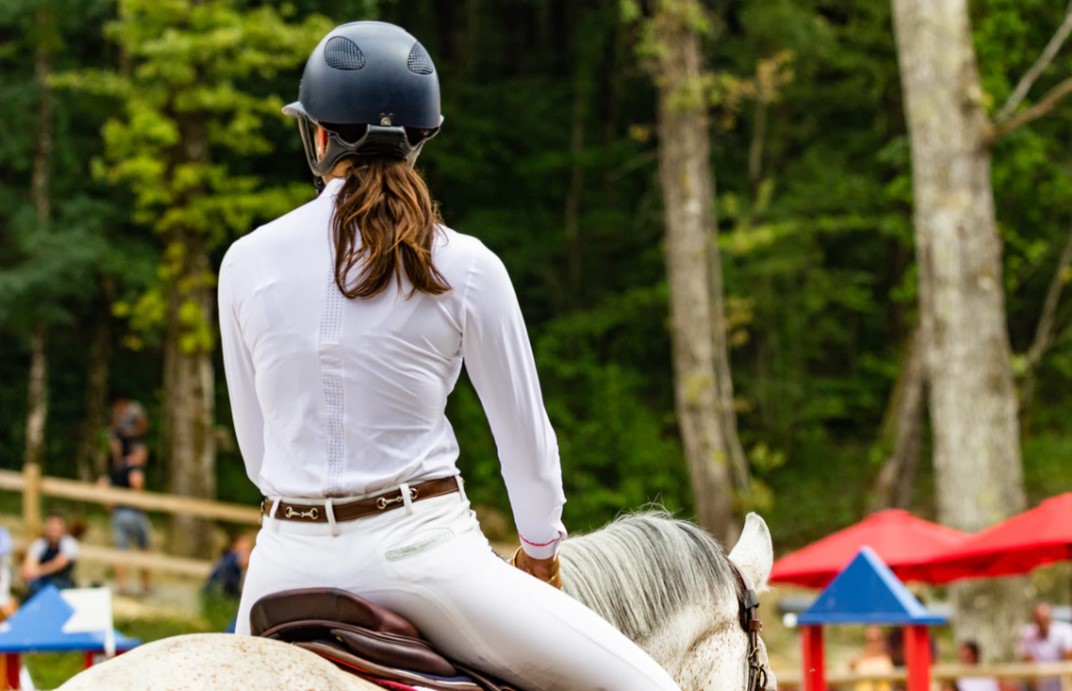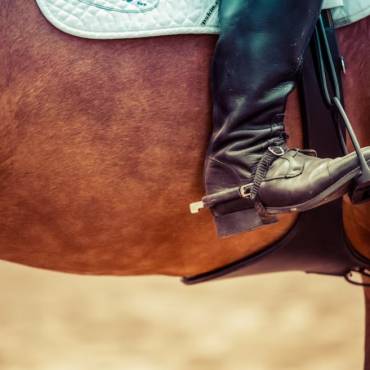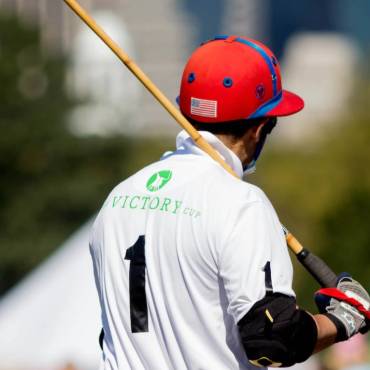In the featured photo, Elisa Müller is riding her 7-year-old Zangersheide stallion Alpha Armani in Brazil. She is working with him at Training Level. How exciting it is to get pictures from all over the world—especially in these times, when suddenly travel is so restricted. It is wonderful to know the love for horses and dressage is shared globally by a big community.
From the picture, I will guess that Elisa is stretching her horse in rising trot. My first impression of this picture is of mutual trust and concentration. Elisa is riding her stallion in an open arena with no fence in sight. She is trotting him with hardly any contact on the reins and she might actually even be holding the reins only in one hand. The horse follows her balance and appears very relaxed, yet listening to her aids.
I do wish that the nose of the stallion would reach more forward to get in front of the vertical. This picture clearly shows that it is not always the rider’s hand that pulls the horse behind the vertical and instead, it can result from the whole balance of the horse’s movement. A stallion often has a strong and big neck that can be a heavy lever, affecting his balance in both positive and negative ways. Often, young horses tend to curl their necks in a bit to keep their balance, but with time and correct training, they can learn to reach forward more with the neck. The horse must be strong enough in the back to be able to stretch forward with the neck through his whole topline.
For Elisa, it is important that she works on improving elasticity in her stallion and asking him to push better off his hind legs. She must do this carefully, though. If she only asks him to go more forward, he might end up on the forehand. So, she should ride many transitions, within gaits and between gaits, that can help to strengthen her horse’s back and improve self-carriage.
Elisa’s position shows nice alignment. She appears as though she is slightly in front of her horse’s movement, but I suspect this is partially because she is just sitting down in the rising trot. Although it is ideal for a rider to be perfectly balanced within the horse’s movement, that isn’t always possible, and given the choice between two extremes, I actually prefer for a rider to be a little in front of the movement rather than behind it.
When I look closely at her ankle, I notice that she is not pulling her heel up, but she is not allowing it to drop down enough. A supple and elastic ankle is particularly important in the rising trot. The following unmounted exercise may help her to feel more elasticity down through her ankle. Try this:
1. Choose two books that are each about an inch thick. Place them on the floor in front of you and then stand on them, barefoot or in socks, in such a way that the ball of your foot is on the books, where your stirrup would normally be placed. When you stand straight, your heels should be able to remain on the ground without effort or much stretching required.
2. Slowly shift your weight from your hips forward until your heels come slightly off the ground. Your balance should be secure, and it is important that your toes are not curling down but can spread out and move freely. I once learned a tip to ride as if I wanted to play piano with my toes, which helped me control the stirrup easier and feel better contact with my calf on my horse’s side.
3. Holding this position, start bending your knees a bit and then straightening them again.
This trains your balance for the rising trot by keeping your ankle elastic and supple. Rising trot is a bit more like squatting and requires that your feet are stable in the stirrups. Your weight in the stirrups should remain as steady as possible during the rising and sitting moments.
As Elisa gets better at this, she may be able to connect deeper with her seat, even when she is posting the trot. This is because a rider’s seat becomes more stable when she is able to steadily reach down into the stirrups. During the rising phase of the posting, gravity should pull the rider into the stirrups. Keeping this same contact on the stirrups while sitting down helps to deepen the rider’s seat without sitting heavy on the horse’s back.
This connection will enable Elisa to be more effective when she wants to tap into Alpha Armani’s engine (hind legs) and encourage him to use his hind legs better under his weight.
My guess from this picture is that Elisa and her stallion can be very steady, keeping the same rhythm and tempo. This is important for Training Level. To enhance balance and activity, she can start to play with the rhythm even more. A great method to learn how to prepare and time your aids better is to count a set number of steps between transitions. For example, canter for 10 strides, then trot. Post 10 times and then canter again. When you have mastered this, reduce the number of strides between transitions. You could do this by reducing to five strides between transitions and then just three strides.
Including walk–trot transitions can be very educational, too, for both horse and rider. For example, start in trot, ride the transition to walk for five steps and then trot on again. When the trot–walk–trot is established, change it up. Walk and ask for only five strides of trot before walking again. The numbers can vary depending on the situation and your mastery of the exercise.
Riding quick transitions helps you learn to react quickly and it keeps your balance and posture more dynamic. The horse, too, will find it easier to develop activity in his hind end and self-carriage and will feel more in-tune with the balance of the rider. This is the foundation for good half-halts and this idea can also help you feel how to use them to enhance balance within movement.
Being able to count and control a set number of strides before performing a transition is an extremely helpful tool for riding a test. It teaches you to think ahead, to learn just how long it takes to prepare good transitions and it teaches the timing of the aids to perform transitions at a certain letter in the arena.
I am sure that Elisa can use these exercises to develop her riding on her beautiful stallion and I wish them many happy and healthy rides together.
Original article: Improve Elasticity in Horse and Rider (dressagetoday.com)
Royal Equestrian – Riding Apparel, Horse Fashion, Horse Tack (royalequestriancollection.com) – check our website to purchase and enjoy our products for your horses and you.





Add Comment